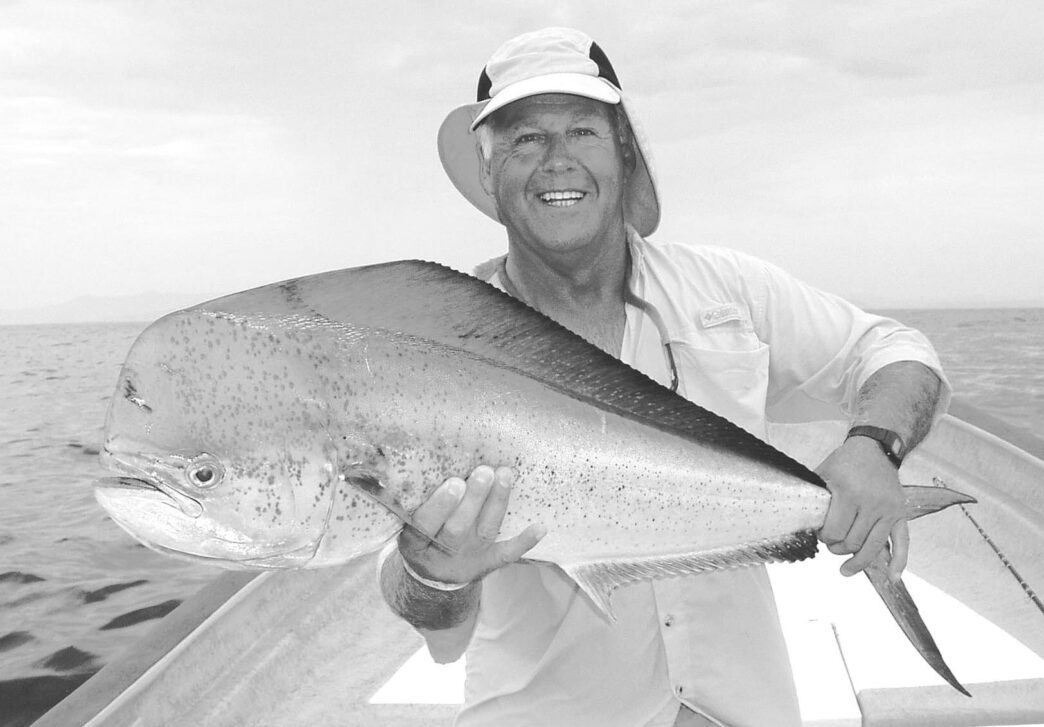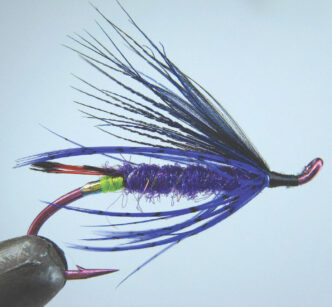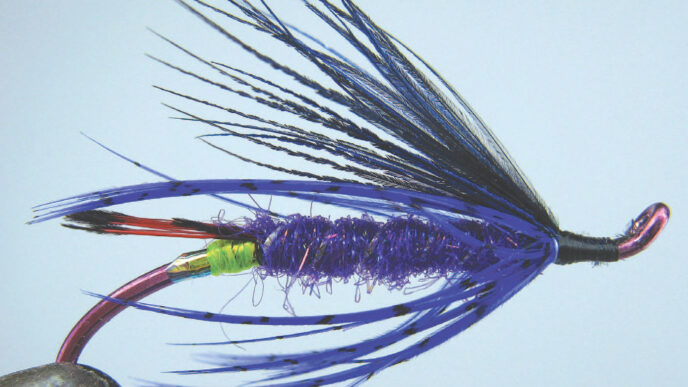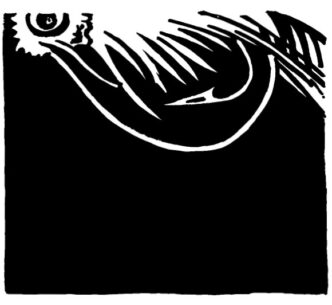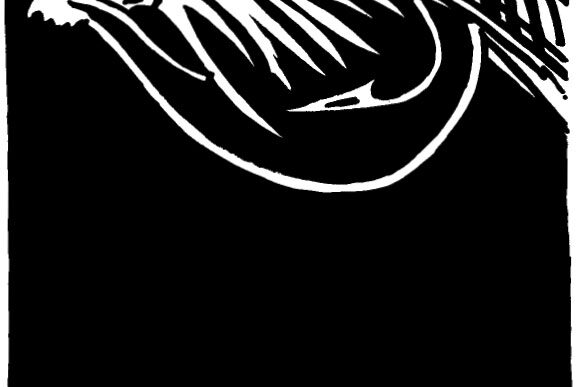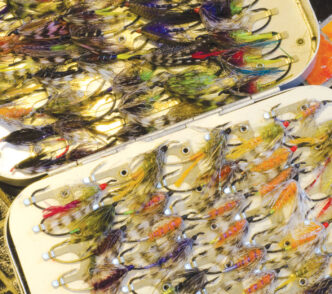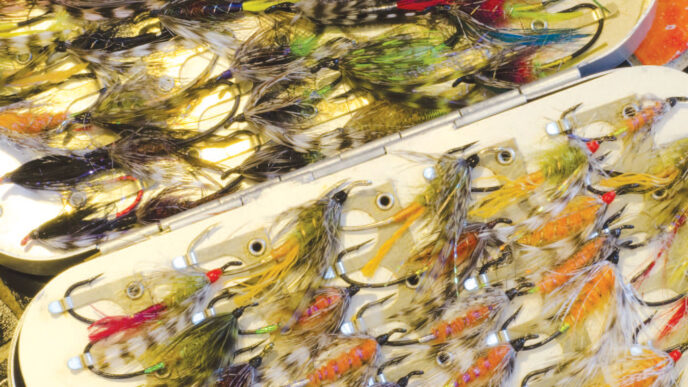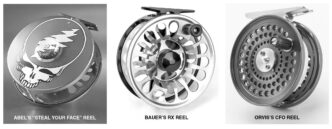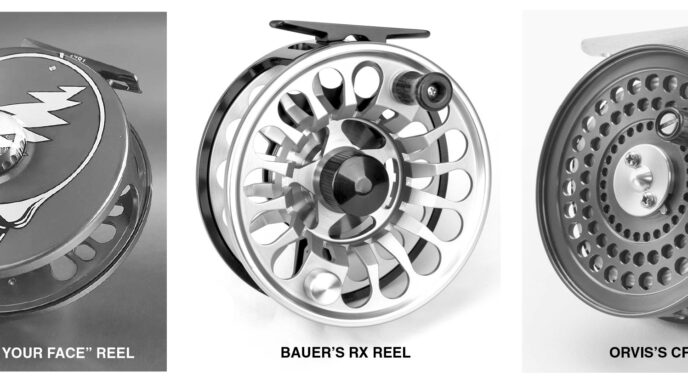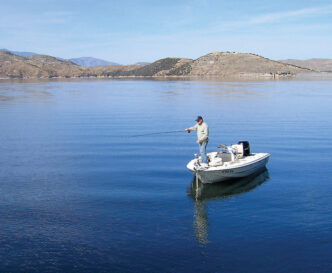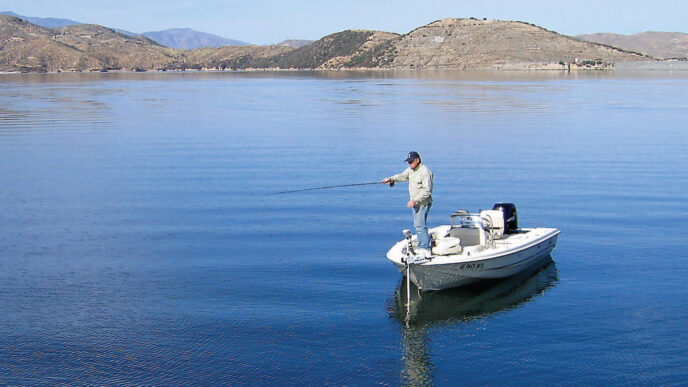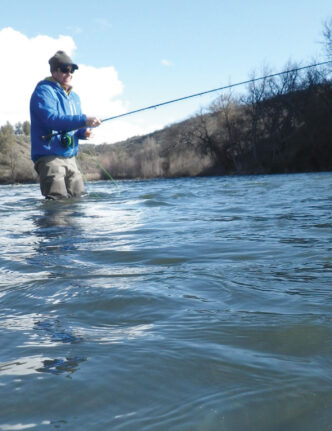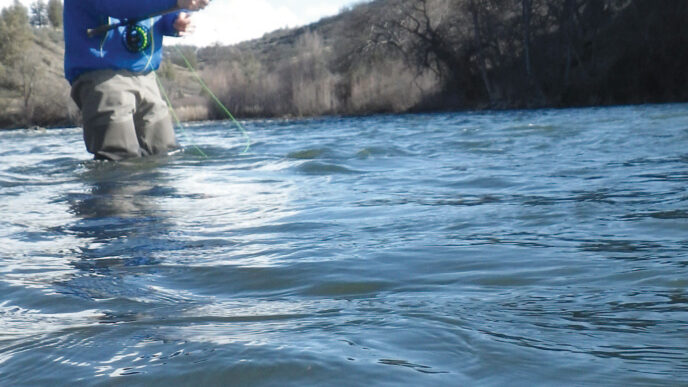About 14 years ago, I was inspired by several fly fishers who told stories about fishing Baja California for dorados and other saltwater denizens of the Sea of Cortez. They told me that the dorados caught there are the perfect fly-rod fish. A dorado can burst through the water at speeds over 50 miles per hour and crush your top-water fly and then, after being hooked, race off for a hundred yards and launch itself completely out of the water 10 feet into the air as it performs somersaults. And while the dorado fishing was what brought most anglers to Baja, there were sailfish, marlins, and roosterfish in the same area, all willing to eat a fly.
These anglers were all fishing veterans of the Sea of Cortez in an area about 700 miles south of the Mexican border in Baja. They always stayed in the sleepy little town of Loreto, where they have the ideal setup for team fishing out of the small boats called pangas. I, too, became addicted to this type of fishing after my first trip to Loreto over a decade ago, and since then, I have accumulated almost a year’s worth of fishing days from my annual excursions. Maybe some of what I have learned will inspire you to plan a trip, too.
Loreto: A Baja Angling Adventure
Your local fly shop is a good place to start to connect you with travel groups or agencies knowledgeable about Loreto and its angling. You could also check out Fishing International tional.com) or Fishabout (http://www.fishabout.com). Both of these California businesses have been booking trips to Loreto for more than three decades, and each can also point you in the right direction regarding airline connections.
In Loreto, most veteran anglers stay at the Oasis Hotel, which has been catering to fishermen for over 50 years. It’s conveniently located about half a mile from the airport, and you have to walk only about 200 feet to the beach to get to your panga. Hotel staff members are available upon your arrival to sell you the required fishing license and marina tag and to take your beverage orders for the next day’s fishing (paid for separately — and each panga is equipped with an ice chest). Wakeup calls are at five o’clock in the morning, and after breakfast at the hotel restaurant, you go back to your room, put on your sunscreen, grab your gear, and head to the beach to board your assigned panga. Then the captain pushes off and idles over to the harbor.
The first stop of the morning is the harbor area where the sardinas congregate, and they are most abundant just as the sun comes up. The captain makes about five or six attempts with his throw net, which should ultimately land you about 200 flatiron herring, or sardinas, a quantity that will fill your bait box and provide chum for the day. There are also boats on the water selling sardinas that were harvested the day before, but if your captain nets them fresh, they survive longer.
During this time, your panga anglers and captain have a chat and decide what species of fish you’re going for that day. On my first trip, I was pleasantly surprised to learn that because the dorado fishing can be so spectacular, many of the veterans of Loreto often don’t speak of the sailfish, marlins, and roosterfish that are also available at the same time — but those species definitely can be targeted, as well. You also have to tell the captain if you are going to kill a dinner fish, which would be a larger (older) male dorado. It is very frowned upon ever to kill a billfish or a roosterfish, and you should never kill a female of any gamefish species.
For dorados, sailfish, or marlins, you travel out to sea a lot farther looking for current lines, rips, floating debris, and of course Sargasso grass, which is a weed that grows on the rocks underwater and at certain times of the year breaks off and floats to the top in patches that can be as large as 30 to 40 feet in diameter. Sargasso grass is usually a dark orange color, and dorados love to hang out underneath it.
Dorados
Trolling, sight fishing, and chumming up fish at patches of Sargasso grass are the best methods for finding and catching dorados. I like to incorporate all three into one operation.
The most exciting, deadly, and productive way I know of to attract dorados is to use a big, pink, foot-long tube trolling fly. Dorados, sailfish, and marlins will attack it on sight. When trolling, not only are you in total hunting mode, but your eyes are focused on the horizon for diving birds, patches of Sargasso grass, or any other type of flotsam — even dead sea life such as whales, seals, or turtles — any of which may harbor dorados. Large groups of dorados can also congregate in the open sea, so you also have to be on the lookout for clues to their whereabouts.
When we troll, we aren’t trolling to catch a trophy. We are trying to find and locate any single dorado, then catch it and hold it near the boat in an attempt to chum up a pack of fish to which to cast. As you troll along, one or more of an unseen group might attack your trolling flies.
That’s when the fun begins. You have the whole pod of fish to yourself. I begin by fishing a 12-weight rod with a clear floating line and a Crease Fly. When I hook the first fish and bring it next to the panga, I usually hand the rod off to the captain and grab another rod rigged the
same way. As the other fish in the pack start showing up out of curiosity (maybe they’re just tire kickers, hungry, or nosey), we toss in a few sardinas. As soon as the free meal is spotted by the new arrivals, the fishing action explodes. The water in front of you will look like a battlefield in full attack mode. The whole pack will come swarming in, and you will be surrounded by dorados, with sardina scales, sardina body parts, and blood floating on the surface. There will be a full-blown blitz going on. Your heart will be pounding, your reel will be crying, and your fishing partner will be hollering with delight as you’re casting and catching dorados one right after another. It’s possible to repeat this scenario several times a day.
When the action slows down and the craziness subsides, I reel in the Crease Fly and start using a 12-weight rod with a 26foot sink-tip line and a sardina-looking fly, and for a while, I once again get them on what seems like every cast. As the second act winds down and exhaustion sets in for the fish and anglers alike, it’s time to leave and go search for a fresh pack of fish.
It’s good to keep in mind that if you hadn’t trolled, you probably wouldn’t have any fish at this point. Also, if you don’t troll, you have to monitor your panga’s radio or follow the other pangas out to sea in their search for a patch of Sargasso grass with dorados under it. As soon as the first captain in the fleet finds a pack of dorados, he gets on the radio and lets the world know his location and what he found, and most of the time, when you arrive there, a large cluster of pangas already has beat you to it. The dorados are either almost full of sardinas or have become a lot more difficult to catch.
Very soon after the first radio episode, your captain may announce that there are a couple of large patches of Sargasso grass ahead and to get ready with poppers or Crease Flies again. He will slide the panga to a halt about 30 feet from the patch and throw in a few sardinas. All of a sudden, it can look like a land mine went off as the dorados swirl and jump and make mincemeat of the chum.
In this scenario, I try to do some cherry picking by casting only to the larger bulls. Sometimes after I’m hooked up with what I thought was the biggest dorado in the pod, all of a sudden, a monster dorado will appear from out of nowhere. Then, just as when trolling, I usually hand the rod with the hooked fish to the captain and grab a different 12-weight in an attempt to get the new giant. This an effective way to catch the largest trophies.
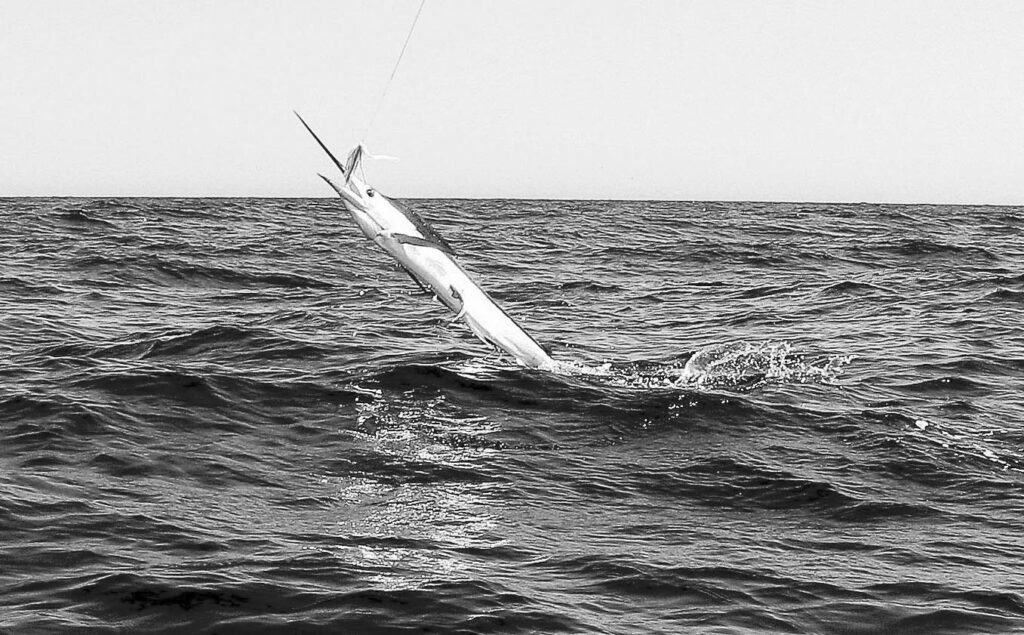
It’s also not uncommon to have a hooked dorado spit out your fly during its aerial gyrations, only to have another one crash through and grab it. Then you’re off to the races again with a different fish.
If you’re fighting fish for a while, you might notice other pangas starting to arrive at your patch of Sargasso grass, and they might even try to lure the pod of fish over toward their pangas by using more chum. At that point, the dorados begin to get overfed and picky. And occasionally your lines get tangled up with the lines of the other anglers. At times like this, it’s just easier to reel in and go look for fish elsewhere.
Sometimes, when motoring along very slowly, we spot free-swimming dorados making Vs on the water surface. This is another opportunity to start a wide-open bite again. Or sometimes while trolling, we spot frigate birds diving, and we go to investigate the situation. It may turn out to be a few hundred dorados chasing flying fish on the surface, or it might be a dozen or more sailfish with a large bait ball, or it could even be a large pack of jack crevalles chasing bait. Whatever it is, we need to be ready with Crease Flies, because any of these fish will pound those top-water flies with reckless abandon.
Sailfish and Marlins
After an exciting encounter with the crashing bait, you start trolling again. You never know what’s going to happen next. Often, you will spot a sunning sailfish all by itself. These singles are extremely tough to entice to bite, but if there are more than one, your odds go way up. They get extremely competitive. Again we reel in the trolling rods and grab the 12-weight rods with the Crease Flies, then we ease the panga slowly and quietly into casting range, 40 to 50 feet away, and toss a chum of sardinas to the fish. We try to get them eating in a rhythm and cast the Crease
Flies in front of them, but you can’t retrieve the flies toward the fish — no baitfish swims toward a predator that’s trying to eat it.
As soon as a sailfish eats your fly, you naturally want to strike at the same instant, but you must refrain and wait until the fish turns its head and starts to swim away, otherwise, you will pull the fly right out of its mouth. The moment the fish turns its head, strike as hard as you can. Just as soon as the sailfish or marlin is hooked, you will witness the fastest fish in the sea just tear up the water for two or three hundred yards. Your reel will be crying and begging for mercy, and your eyes might bug out of your head as you watch the antics and acrobatics that these fish can perform, leaving lasting memories.
Be ready for the boat to start following the hooked fish, no matter how much backing your reel has. If it’s your first billfish, you will have a smile three feet wide, busted knuckles, and a swelled head. I know I did. Make sure your fishing partner is ready to cast as you land the first hooked fish, because other sailfish will sometimes follow the hooked fish right to the panga.
Roosterfish
If you want to fish for roosterfish, you have to pursue them along the shore and beaches. Sailfish and dorados can be found swimming next to each other out at sea, but most of the roosters are found along the shoreline. Consequently, when we head out in the morning to look for roosters, we know pretty much where we are going and where they are. When we get to the rooster farm, we usually hook a sardina on a bare hook and troll it about 75 feet behind the boat, very slowly. Every so often, the guide will throw out a few handfuls of sardinas.
If the roosters are there, all hell can break loose. Suddenly, the rod with the hooked sardina bends double, and there are roosters with their big combs sticking high out of the water going in all directions. Now your partner, who is using a clear floating line with a Crease Fly tied on, will cast at the darting roosters of his or her choice. When your partner is hooked up, you can bring in the trolled-up rooster, switch roles, and do it all over again.
As soon as your welcome at that spot has been worn out, pick up and move to the next rooster hole. If you keep a sharp lookout along the shore, you might find some roosters crashing bait on the beach. If you encounter that scenario, those fish aren’t hard to hook, especially if you have sardinas as chum.
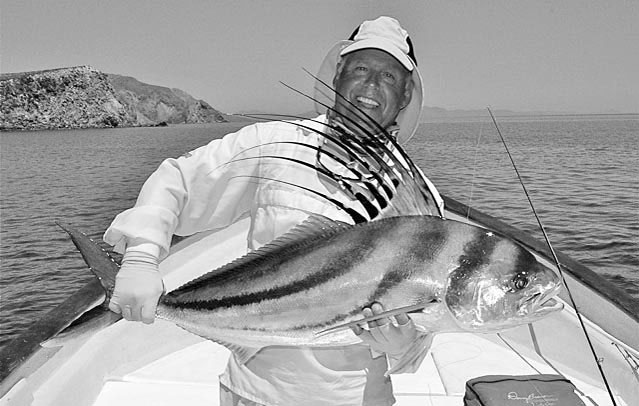
Fly Rods
I take at least four quality fly rods with me to Loreto. I always have three in the boat and leave one in the hotel room for a spare. My boat arsenal is two 12-weight rods and one 14-weight rod for trolling. You might get away with a smaller 10-weight rod, but I would rather be a little overgunned sometimes and not undergunned at any time.
Reels and Lines
If you decide to skimp on any part of your equipment, skimp someplace else, but don’t skimp on your choice of reels. Your reels will be put to the test constantly. I take four 12-weight heavy-duty, American-made reels with large cork drags. Each reel is equipped with 500 yards of 50-pound braid backing. Anything that can break in Loreto will break. I carry my spare reel in my boat bag.
As noted, I use a clear floating 12-weight line on one reel for Crease Flies and a 12-weight, 26-foot sink-tip line on the other reel for casting sardina flies. (Sometimes I use a clear intermediate, depending on conditions.) All lines are full length, but on the trolling rod, I use a 30-foot sinking shooting head (550 grain). I make my own running line from 150 feet of 50-pound clear monofilament.
Leaders
Most of my leaders for dorados, sailfish, and marlins are the same, usually 6 or 7 feet of 30-pound-test monofilament with about 2 feet of 80-pound bite leader coupled using a Slim Beauty knot. Dorados have little hacksaw-type teeth that in a long fight will cut your leader. Similarly, billfish beaks are quite abrasive. Leaders for roosterfish are usually untapered 20-pound-test fluorocarbon. Roosters have soft mouths. Leaders for the trolling lines should include a swivel in the middle of the leader to prevent twisting.
Flies
I use only three different kinds of flies in Loreto. For trolling, searching, and attractor patterns and to bring up feeding fish from far below and far away, I always tie and use a 12-inch tube fly in bright pink and white or blue and white. These flies have a two-hook rig, an 8/0 in the front and a 6/0 in the rear.
For the top-water bite, I use tube Crease Flies in dark green with a silverchrome belly and dark blue with a silverchrome belly. I also use a tube Crease Fly in light brown with a silver-chrome belly to represent the sardinas we use for chum. The best trick I know when using these flies is to cast your fly out, then have the boat captain toss the sardinas at your fly. If he tosses the sardinas first, they will be eaten before you can get your fly into the same area.
The third kind of fly that I use is a deer hair fly with an epoxy front end and big eyes. I like dark olive or dark brown over white or even light brown over white. I like to use at least a 4/0 hook, and the fly should be about five inches long. Make sure to add a few wraps of lead in the front to make the fly nose dive after you strip it.
Be Ready to Be Impressed
Every year the fishing action is a little different in Loreto. Some years, the dorados are extremely abundant, and other years, you may catch more marlins or roosterfish. Depending on the temperature of the waters, weather patterns such as El Niño or La Niña, and the availability of sardinas, you may find you have better luck with one species than another in any given year. But the bounty of fish offered up by the seas off the coast of Loreto will practically guarantee that any excursion there will be an adventure.




